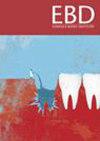Antimicrobial resistance genes in the oral microbiome
Q3 Dentistry
引用次数: 0
Abstract
Sukumar S, Rahmanyar Z, El Jurf H Q et al. Mapping the oral resistome: a systematic review. J Med Microbiol 2024; https://doi.org/10.1099/jmm.0.001866 . This systematic review, without meta-analysis, aimed to map the oral resistome by analysing clinical studies that detected bacterial antimicrobial resistance genes (ARGs) in the oral cavity using molecular techniques. The researchers used Medline, Embase, Web of Science, CINAHL and Scopus databases from January 2015 to August 2023. This systematic review included cross-sectional or longitudinal clinical studies that detected ARGs using molecular techniques; specifically polymerase chain reaction (PCR) or next-generation sequencing (NGS) metagenomics for samples from the oral cavity (saliva, gingival biofilm, pulp, or oral mucosa). Studies were excluded if they were in vitro or animal studies, literature reviews and not focused on ARG detection. Five reviewers independently screened titles and abstracts based on inclusion criteria. Full-text reports were then independently assessed for eligibility by three reviewers. Extracted data encompassed publication details, sample size, country, molecular methods used, number of ARGs detected, participants’ health status, antibiotic exposure, and sample location within the oral cavity. Out of 580 initially identified studies, 15 met the inclusion criteria. These studies, published between 2015 and 2023 from 12 different countries, employed either PCR (n = 10) or NGS metagenomics (n = 5) to detect ARGs from a pool of 1486 participants (1 study did not report on the number of participants). PCR-based studies identified an average of 7 ARGs (range 1–20), while NGS studies identified an average of 34 ARGs (range 7–70). In total, 159 unique ARGs conferring resistance to 22 antibiotic classes were identified across six regions of the oral cavity. The supragingival biofilm and saliva exhibited the highest richness of ARGs, defined by the number of unique ARGs detected. Genes conferring resistance to 19 antibiotic classes were present in the supragingival biofilm. Notably, 49 ARGs, including tetracycline and macrolide resistance genes, were found across all sampled locations, indicating a widespread distribution within the oral cavity. Thirteen studies reported on bacterial species associated with ARGs. NGS studies identified a mean of 65 ARG-carrying bacterial species, compared to a mean of 4 species in PCR studies. Specifically, 25 ARG-carrying species were identified in PCR studies, while NGS studies identified 177 species. Four studies reported ARGs associated with streptococcal species implicated in distant-site infections such as infective endocarditis. ESKAPE pathogens (group of highly virulent multidrug-resistant bacteria) were detected with ARGs in various oral sites using both PCR and NGS methods. Comparisons between healthy and diseased states revealed that a healthy oral microbiome harbours a more diverse resistome at the antibiotic class level. The supragingival resistome demonstrated the richest composition in both health and disease, with tetracycline ARGs predominating in the supragingival and saliva resistomes in cases of dental caries. The analysis of the oral resistome from these 15 studies identified three ARGs present in all sites of the oral cavity, suggesting the presence of a core resistome. NGS studies provided greater insights compared to PCR studies; however, the overall research base is limited. Further comprehensive studies are necessary to fully map the oral resistome.口腔微生物组中的抗菌素耐药基因。
Sukumar S, Rahmanyar Z, El Jurf H Q等。绘制口腔抵抗组:系统回顾。中华微生物学杂志2024;https://doi.org/10.1099/jmm.0.001866 .设计:本系统综述未进行meta分析,旨在通过分析使用分子技术检测口腔细菌抗微生物药物耐药基因(ARGs)的临床研究,绘制口腔抵抗组图谱。数据来源:2015年1月至2023年8月,研究人员使用Medline, Embase, Web of Science, CINAHL和Scopus数据库。研究选择:本系统综述包括使用分子技术检测ARGs的横断面或纵向临床研究;特别是聚合酶链反应(PCR)或下一代测序(NGS)宏基因组学,用于口腔样本(唾液,牙龈生物膜,牙髓或口腔粘膜)。排除体外或动物研究、文献综述和不关注ARG检测的研究。数据提取和综合:五名审稿人根据纳入标准独立筛选标题和摘要。全文报告随后由三名审稿人独立评估是否合格。提取的数据包括发表细节、样本量、国家、使用的分子方法、检测到的ARGs数量、参与者的健康状况、抗生素暴露和样本在口腔内的位置。结果:580项初步确定的研究中,15项符合纳入标准。这些研究发表于2015年至2023年间,来自12个不同的国家,采用PCR (n = 10)或NGS宏基因组学(n = 5)从1486名参与者中检测ARGs(1项研究未报告参与者数量)。基于pcr的研究平均鉴定出7种arg(范围1-20),而NGS研究平均鉴定出34种arg(范围7-70)。在口腔的6个区域共鉴定出159种对22种抗生素具有耐药性的独特ARGs。龈上生物膜和唾液显示出最高的ARGs丰度,这是由检测到的独特ARGs的数量来定义的。在龈上生物膜中存在对19种抗生素具有抗性的基因。值得注意的是,包括四环素和大环内酯类耐药基因在内的49种ARGs在所有采样地点均被发现,表明其在口腔内分布广泛。13项研究报告了与ARGs相关的细菌种类。NGS研究平均鉴定出65种携带arg的细菌,而PCR研究平均鉴定出4种。其中,PCR研究鉴定出25种携带arg的物种,而NGS研究鉴定出177种。四项研究报告了ARGs与远端感染(如感染性心内膜炎)相关的链球菌种类。应用PCR和NGS方法检测ESKAPE病原菌(一组高毒力多重耐药菌)在口腔各部位的ARGs。健康和患病状态之间的比较表明,健康的口腔微生物组在抗生素类水平上具有更多样化的抗性组。在健康和疾病中,龈上抵抗组的组成最丰富,在龋齿病例中,四环素ARGs在龈上抵抗组和唾液抵抗组中占主导地位。结论:对这15项研究的口腔抵抗组的分析发现,三个ARGs存在于口腔的所有部位,表明存在一个核心抵抗组。与PCR研究相比,NGS研究提供了更多的见解;然而,整体研究基础有限。需要进一步的综合研究来全面绘制口腔抵抗组。
本文章由计算机程序翻译,如有差异,请以英文原文为准。
求助全文
约1分钟内获得全文
求助全文
来源期刊

Evidence-based dentistry
Dentistry-Dentistry (all)
CiteScore
2.50
自引率
0.00%
发文量
77
期刊介绍:
Evidence-Based Dentistry delivers the best available evidence on the latest developments in oral health. We evaluate the evidence and provide guidance concerning the value of the author''s conclusions. We keep dentistry up to date with new approaches, exploring a wide range of the latest developments through an accessible expert commentary. Original papers and relevant publications are condensed into digestible summaries, drawing attention to the current methods and findings. We are a central resource for the most cutting edge and relevant issues concerning the evidence-based approach in dentistry today. Evidence-Based Dentistry is published by Springer Nature on behalf of the British Dental Association.
 求助内容:
求助内容: 应助结果提醒方式:
应助结果提醒方式:


